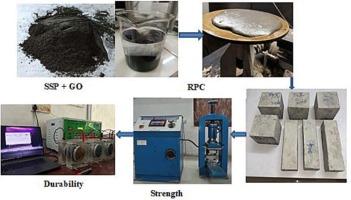Response surface methodology based optimization of graphene oxide dosage in reactive powder concrete for strength enhancement
IF 5.1
3区 材料科学
Q2 MATERIALS SCIENCE, COATINGS & FILMS
引用次数: 0
Abstract
This study reports a nano-modified Reactive Powder Concrete (RPC) with Graphene Oxide (GO) and steel sludge powder (SSP) for improved mechanical performance, durability, and microstructural properties. Several samples were made with different percentages of GO and were comparatively studied with respect to traditional RPC. The study ensured a well-graded particle size distribution with cement (<70 μm), silica fume (<1 μm), quartz sand (150–300 μm), and steel sludge powder (∼300 μm) to obtain the optimum densification. Steel sludge powder was added as an additional material to improve sustainability. Experimental investigations included workability testing, compressive strength, flexural strength testing, and durability testing, including sorptivity and rapid chloride permeability. Microstructural analysis was performed to find out the internal matrix refinement. The findings revealed that a 0.09 % addition of GO improved compressive strength to 85 MPa compared to the normal RPC compressive strength of 48.7 MPa. Similarly, flexural strength was enhanced from 4.6 MPa (normal) to 8.32 MPa for RPC with GO. The findings suggest that the optimal percentage of nanoparticles in dispersion is a prerequisite for property improvement in RPC, and excessive use may lead to negative performance.

基于响应面法的活性粉末混凝土氧化石墨烯掺量优化研究
本研究报告了一种纳米改性活性粉末混凝土(RPC),其中含有氧化石墨烯(GO)和钢泥粉(SSP),可改善机械性能、耐久性和微观结构性能。用不同比例的氧化石墨烯制作了几个样品,并与传统RPC进行了比较研究。通过水泥(70 μm)、硅灰(1 μm)、石英砂(150 ~ 300 μm)、钢泥粉(~ 300 μm)等,确保了良好的分级粒度分布,以获得最佳密度。添加钢泥粉作为附加材料,提高可持续性。实验研究包括可加工性测试、抗压强度测试、弯曲强度测试和耐久性测试,包括吸附性和快速氯化物渗透性。进行了显微组织分析,找出了内部基体细化的方法。结果表明,与普通RPC的48.7 MPa的抗压强度相比,添加0.09%的氧化石墨烯可将抗压强度提高至85 MPa。同样,含有氧化石墨烯的RPC的抗弯强度从4.6 MPa(正常)提高到8.32 MPa。研究结果表明,分散体中纳米颗粒的最佳百分比是改善RPC性能的先决条件,过度使用可能会导致性能下降。
本文章由计算机程序翻译,如有差异,请以英文原文为准。
求助全文
约1分钟内获得全文
求助全文
来源期刊

Diamond and Related Materials
工程技术-材料科学:综合
CiteScore
6.00
自引率
14.60%
发文量
702
审稿时长
2.1 months
期刊介绍:
DRM is a leading international journal that publishes new fundamental and applied research on all forms of diamond, the integration of diamond with other advanced materials and development of technologies exploiting diamond. The synthesis, characterization and processing of single crystal diamond, polycrystalline films, nanodiamond powders and heterostructures with other advanced materials are encouraged topics for technical and review articles. In addition to diamond, the journal publishes manuscripts on the synthesis, characterization and application of other related materials including diamond-like carbons, carbon nanotubes, graphene, and boron and carbon nitrides. Articles are sought on the chemical functionalization of diamond and related materials as well as their use in electrochemistry, energy storage and conversion, chemical and biological sensing, imaging, thermal management, photonic and quantum applications, electron emission and electronic devices.
The International Conference on Diamond and Carbon Materials has evolved into the largest and most well attended forum in the field of diamond, providing a forum to showcase the latest results in the science and technology of diamond and other carbon materials such as carbon nanotubes, graphene, and diamond-like carbon. Run annually in association with Diamond and Related Materials the conference provides junior and established researchers the opportunity to exchange the latest results ranging from fundamental physical and chemical concepts to applied research focusing on the next generation carbon-based devices.
 求助内容:
求助内容: 应助结果提醒方式:
应助结果提醒方式:


